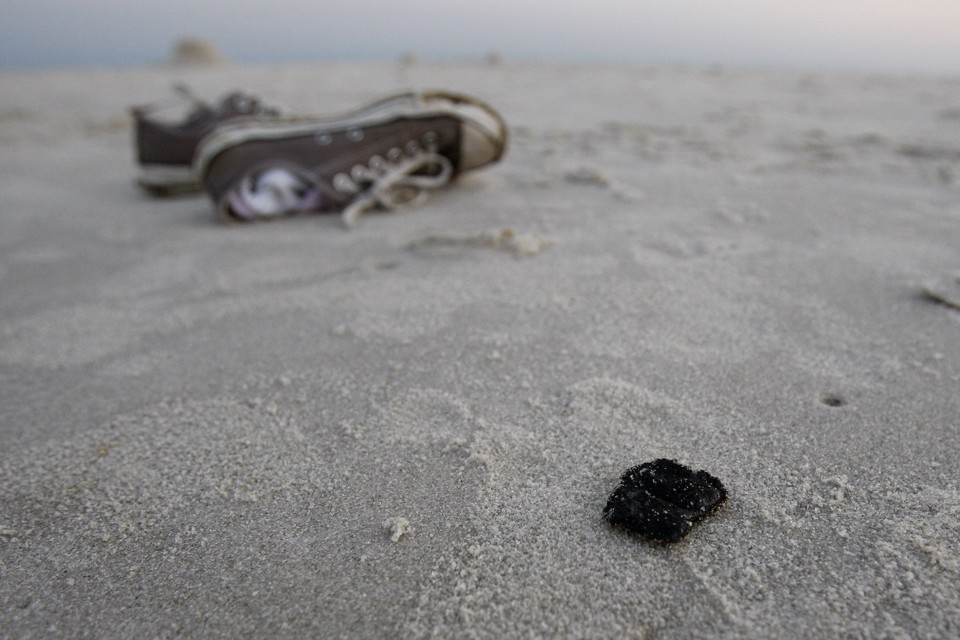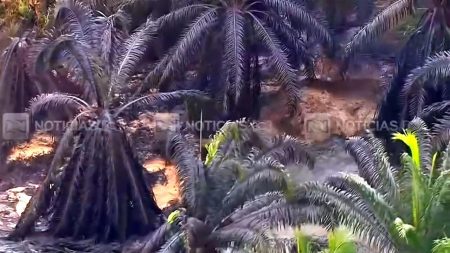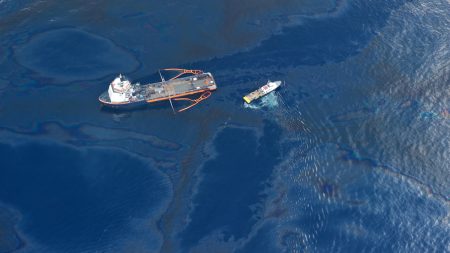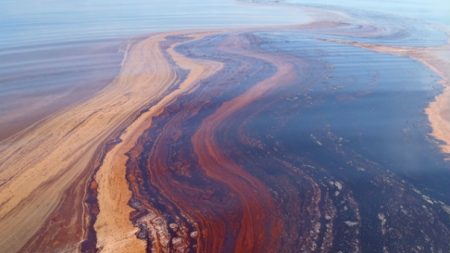Tar Balls, the Beach’s Fossil-Fuel Flowers

Since my recent move to Tucson, Arizona, a wave of nostalgia has engulfed me. I miss the Pacific. I’ve been thinking about the Western horizon where the ocean kisses the sky, the salt air stays on my lips, and where tar balls, masses of fragrant black goo, sometimes stick to the bottom of my feet.
A child of the ’70s growing up in Southern California, I recall the tar balls’ thick petroleum fragrance—and how once they were lodged on the sole of the foot, they were difficult-to-remove but oddly comforting little reminders of a splendid day at the beach. I began thinking about where they come from, how they got to be tar balls, and if they were bad or benign.
* * *
Christopher Reddy is a marine chemist based at the Woods Hole Oceanographic Institution in Massachusetts. I first chatted with him in April 2010 about the Deepwater Horizon marine oil spill, the largest in U.S. history. Reddy and his colleagues harvested oily samples from the shoreline to a makeshift lab in a double-wide trailer. It was dirty, manual work. When we spoke, Reddy had just returned from a nearby hardware store, where he had stocked up on Mason jars, aluminum foil, and metal spoons, low-tech but effective equipment to collect and ferry samples from the beach to the bench.
So, I contacted Christopher Reddy again, and his collaborator, Dave Valentine, to see what they had to say on the subject of tar balls. Reddy and Valentine are long-time collaborators. Reddy tends to concentrate on oil spills, old and new, and Valentine tends to favor oil seeps. Seeps are regions of the seafloor that naturally leak oil and gas. Both spills and seeps yield tar balls.
“Dave and I had a blind date arranged by a colleague of ours around 2003,” explained Reddy. “I went to the University of California, Santa Barbara, and I learned about natural oil seeps, where oil travels through cracks in the ocean floor.” A tortuous path, he adds. “Where there’s a natural oil seep, there’s a reservoir beneath it,” says Reddy.
Like Reddy, Valentine was also trained as a chemist, although he didn’t begin his career working with petroleum. Instead, he focused on how microorganisms impact the chemistry of the oceans. “I stayed away from petroleum because no on could tell me what was actually in it,” he explains. Petroleum, a liquid mixture of hydrocarbons, is so complex that, back when he was starting his career, researchers truly couldn’t determine what it contains. But then he met Reddy, who had figured out a method of resolving a lot of that complexity. “Now, I could understand what was going on at the chemical level and combine that with what microbes can and can’t do, and how they survive in this environment,” Valentine says.
“Seepage has been happening since before humans were here.”
It all came together when Valentine took a job at one of the most prolific petroleum seeps in the world, Coal Oil Point Seeps, located at the bottom of the sea floor half a mile off-shore from Santa Barbara. Valentine now focuses on the microbes and how they access hydrocarbons for energy, on how oil weathers when it’s exposed to the elements, and on the chemistry of tar.
As far as tar balls go, there’s no formally agreed-upon definition, according to Valentine. Tar is a weathered form of petroleum. It’s also a complex mixture of many things, Valentine explains. “We have air, dirt, mud, and tar, a term that is used to capture a whole variety of black mixtures that we don’t have a full chemical handle on.”
But trying to understand what’s in those black mixtures has given rise to the use of chemical fingerprinting of oceanic hydrocarbons, a way to describe the chemical differences between or among tar balls. If you look at the chemical composition of the tar ball, particularly the hydrocarbon composition, every naturally occurring hydrocarbon carries some signature, and it’s the relative proportion of those chemical compounds—found through their respective signatures—that gives clues to the geological origin and environmental history, and thus the identity of tar balls.
One such compound is oleanane, which comes from flowering plants. “If we see oleanane in oil,” Reddy tells me, “we know that oil is 50 million years old or younger, because flowering plants didn’t exist until 50 million years ago.”
Although both Valentine and Reddy study tar balls from natural seeps, early in his career Reddy became intrigued with tar balls originating from manmade spills, especially old ones. Studying old oil spills allows the effects of time to play out on the hydrocarbons that escape during the spill. “I want to know who’s the toughest kid on the block; that is, what compounds last 1,000 years, or 100 years, or 10 years, and what compounds don’t.”
* * *
According to Valentine, tons of oil are continuously released into the ocean both from natural seeps and from human activities, such as spills. The formation of tar is simply part of the natural weathering process of those oils. But is there a difference between tar balls that originate from natural seeps versus ones that originate from spills? It depends.
Source: The Atlantics





